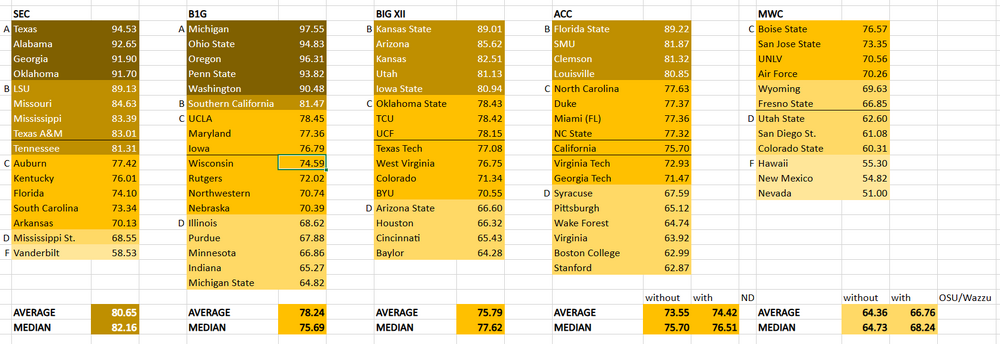-
Posts
2157 -
Joined
-
Last visited
Content Type
Profiles
Forums
Store
Downloads
Recruiting - 2020
2019-2020 Football Season
Football
Entertainment
Sports
News and Business
Cloak Room
Transfer Portal
Recruiting
Events
Posts posted by Hurtlocker
-
-
9 hours ago, TKthunder2 said:
Bingo.
If we assume it’s the Big Ten, SEC, and Big12 in a 3x24 setup with the ACC falling apart you’d have 22 spots in total maximum. That would be enough to take the new ACC+ND+PAC2+2 more like UConn/Memphis.
That clearly won’t happen because it’s just diluting the product. I don’t see the SEC going past 20 and I doubt the Big Ten does either though they are more likely open to it than the SEC.
My feeling is that we’ll see the Big Ten hold until they can get ND and then maybe Stanford, while the SEC will take FSU/Clemson/UNC/UVA when the opportunity arises.
Then the Big 12 will take the top remaining 8 from the ACC. Miami, VT, NCSU, Pitt, Louisville, and Duke are sure things. The final 2 could be Syracuse and GT but I could see passing on GT (markets not as big of a deal anymore) and letting Yormark make a signature move on UConn (they did just win another).
That lineup would be pretty salty with Miami, Oklahoma St, TCU, Utah, VT, K State and Pitt headlining the football side Duke, Kansas, UConn, Louisville, Baylor, Syracuse, and Houston headlining the basketball side, both with plenty of depth in between with teams like NCSU, West Virginia, Iowa St, BYU, Cincy, TX Tech, and Colorado.
Reading that article, 24 may be too many, looks more like 3x20, which if I'm doing my math right, is 10, not 22. If you use those viewer numbers above and assume basketball plays a tiebreaking part if you're a blueblood:
Clearly in: ND, FSU, Miami, Clemson, UNC, Virginia, Duke
Knife Fight for the Final Three: Stanford, Louisville, VTech, Pitt, NCSt, Cal, Cuse
That being said, 64 has been the sweet spot for break away in our discussions for years. At 14, that would be the list above.
I think @Al_4_ISU is onto something though and this "Super League" concept will likely set it off. PE won't stop trying to build it, just because they couldn't do it this time. CFB is leaving a lot of money on the table with fiefdoms, but the SEC and B1G don't want to share money. However, they put it in with this 6 year window, performance pays. If you move to the super league and get rid of the archaic concept of conferences (much like the archaic concept of bowl games was eventually destroyed) you can also start to weed out the schools that still get the free ride, e.g. Vandy, Northwestern, Rutgers, etc. They don't need to be demoted, but you can just pay on tiers on this six-year swing. Share 50% of the cash, divide the rest like:
- Top 16 - 40%
- Second 16 - 30%
- Third - 20%
- Fourth - 10%
If you had a $6.5b contract (regular and post 6 years from now), you'll lose a percent to the PE, so let's give them $500m yearly, leaving you $6b to share (rounding so may not be exact).
- Top 16 - $54.7m (50%) + $87.5m (40%) = $142.2m
- Second 16 - $54.7m + $65.6m (30%) = $120.3m
- Third - $54.7m + $43.8m (20%) = $98.5m
- Fourth - $54.7m + 21.9m (10%) = $76.6m
Now you have relegation without having to have multiple leagues, you make more over all with pooled contracts, you give the opportunity to make more with performance, the top brands will make far more than currently, and you can budget due to a six-year cycle. The schools that underperform and piss Al off for getting paid due to starting life on third base drift to wherever they actually should be.
If I'm the PE, I start talking to Michigan/Texas/Ohio State/USC/Bama/Georgia/NDs of the world, that's where this will get decided.
And, if I'm the PE, I immediately do the same thing with the "Group of Five" with a much smaller number and structure the games to play off days from the top, filling broadcast windows.
-
 1
1
-
1 hour ago, BurntOrange&White said:
This talk and future talk needs its own thread as this may be the super league and not really conference realignment. But rather collegiate sports as a whole.
Yeah this is the next end game. It won't be the top 18 brands on their own, or relegation, but the top 60 some schools will break out to become the next version of the NCAA, for football at least, under the CFP money umbrella.
My guess is the first step is sharing the same set of rules for the sport, players, NIL, etc, but the holy grail will be moving to a full NFL model of media contracts, where all of the schools involved pool broadcast inventory together for the regular season and playoffs. If you think the jump the B1G did in how they structured their last deal was large, leveraging them all together would create a juggernaut that would likely increase media valuations 5-10x over todays.
But before you get there, you need to show you can operate together as a cohesive unit.
-
 1
1
-
-
On 1/25/2024 at 11:50 AM, statsman said:
…and I think you’re getting a $5M per year/per school premium on the contract (based on comp of last contract Fox/ESPN split to this contract), to help OU and Texas leave a year early. That will disappear on the next contract.
Eh, no. Leaving early, contractually with the media partners, actually had to be settled out by giving Fox more. The Big 12 teams did not get a premium for six years to allow a one-year early exit, that's crazy talk. If there was movement the Big12 would have been looking at a $60m average over 6-8 years, due to how their T1 contract was severely undervalued from being so old, now they're looking at a $40m over 6, that's a sizable decrease with the big brand exits. Additionally, they likely got 10-15% less for signing fast. However, after watching what happened to the Pac, resigning at stable rates was the exact right decision. I don't think anyone in whatever the new 16 is going to be called, is going to be complaining about media revenues.
The only increase that occurred here that isn't market dependent is the boosts they gave to the schools coming in, but that was completely paid for by Texas and OU's buy out fees. They basically invested it to lure in more schools, like Colorado and Arizona.
-
On 12/22/2023 at 6:09 PM, notre dame joe said:
Crimson? That color is hard to describe.
I thought it was FSU who demanded a larger payout around 2011 for which they could only trade a long term contract. @Hurtlocker am I wrong?
Not sure on 2011, I thought it was closer to 2016. That's when there was a lot of Clemson/FSU to the Big12 talk and they got all hoity saying the ACC schools were a better academic fit or something. What they wanted was the ACC Network because the SEC was getting a network and making more money. However, building that network cost them 20 years. I think they thought the ACC Network was the golden goose and it would pay out $20+ million a team or something, but, spoiler, it didn't.
-
 1
1
-
-
1 hour ago, bullet said:
So Pac 12 network dies a couple days before the LHN. Everyone laid off by June 28.
End of an era
-
On the FSU front, from the Tampa Bay Times:
We ran an FSU football playoff conspiracy theory by a sports businessman
You don’t have to look hard to find conspiracy theories about why 13-0 Florida State was left out of the College Football Playoff in favor of 12-1 Alabama.
The playoff selection committee’s stated reason, of course, was that the Seminoles were a different team without star quarterback Jordan Travis. FSU’s weaker schedule didn’t help.
Message boards and social media have other ideas — namely that ESPN was pulling the strings on the selection committee. The playoff’s broadcaster either wanted to protect another partner (the SEC) by picking the Crimson Tide or wanted Alabama to boost TV ratings.
There’s no evidence to support the arguments, unless you think the order of helmets behind analyst Kirk Herbstreit was a sign. ESPN partners with the ACC, too, and committee chairperson Boo Corrigan is the athletic director at an ACC school (North Carolina State) that would have made more money with FSU, not Alabama, in the field.
Regardless, we ran the root of the theory by Ray Katz. He’s the chief operating officer of the media rights and business firm Collegiate Sports Management Group and teaches at Columbia University’s sports management program.
Would Alabama be a larger draw for casual fans in a way that FSU wouldn’t be?
“I’m not going to say Florida State would not be,” Katz said. “I think it’s an incredibly compelling story.”
FSU would have added a different name-brand program to the field. Alabama has only missed the playoff twice in 10 years; FSU has qualified for the semifinals once (2014). The Seminoles overcame Travis’ injury to win the ACC as Mike Norvell’s four-year rebuilding process culminated with a perfect season. It’s easy to envision that story attracting viewers.
But the data on Alabama’s dominance is overwhelming.
The Crimson Tide averaged 7.3 million viewers over the 11 games tracked by Sports Media Watch. The dozen FSU games with available data averaged 4.2 million viewers.
“Every week that Alabama is on any kind of reasonable TV platform, they kick butt,” Katz said. “That’s just the reality of the situation…
“I think it’s a Nick Saban effect to some extent. He stirs up the pot. You either tune in to watch him win, or you tune in to watch him lose. That’s just a fact.”
That fact has attracted the interest of politicians.
State Sen. Corey Simon, the former FSU star defensive lineman, wrote on social media after last week’s decision that ESPN has a “vested interest in the SEC participating in the CFP.” U.S. Sen. Rick Scott has asked to see any correspondence between committee members and ESPN and/or the SEC. Gov. Ron DeSantis has set aside $1 million in his proposed budget for possible litigation.
Katz said he has a “real problem with all these popularity contests and prognostications.” How big of an underdog FSU would be in the playoff shouldn’t be a factor.
But if Katz had to buy into an alternative explanation, his wouldn’t involve TV ratings.
“My conspiracy theory is — if there was a conspiracy theory — it’s about them defending why they are going to 12 teams,” Katz said.
When the field expands from four teams to 12 next year, teams that play in the first round and keep winning will play two more games than they would now. The longer season adds more wear and tear on players’ bodies and will cut into students’ class or free time, depending on the schedules.
Katz said an exclusion like undefeated FSU provides a reason to justify expansion; the Seminoles would have made a 12-team field.
“It defends that,” Katz said.
-
Late to the party on this NIL change of stance by the NCAA, but it is a major game changer. Not so much in that kids can get paid, but it is the line in the sand of our next division in college sports. They're trying to say it won't be, but there is no way you can have one set of schools openly paying players and another not yet consider them competitive. As soon as this gets voted on, it will be the FCS, the FBS, and the CFP. This CFP then can start implementing its own rules and regulations, require things that the NCAA cannot to everyone, including mandating participation to investigation and enforcement. (Currently the NCAA receives none of the money from football, but has to handle all of the investigation, with no one being required to participate. Expect that to change.) Some schools can make this change without batting a financial eye, some will do it to stay in the limelight. Many will say "fuck that". It is the beginning of the end for the current FBS structure.
I've seen it estimated that for a school to comfortably adopt the new measures, they'd need to have an athletic department that has revenues of over $100m. As of the last reporting cycle, that includes 49 public programs, with Ohio State at the top and KState at 49 (likely more with privates like ND, USC, Miami, TCU, Baylor, NW and Vandy. All of the schools in that 49 are Power 5:
$200M+: Ohio State, Texas, Bama, Michigan, Georgia
$150m - $199M: LSU, A&M, Florida, Penn State, Oklahoma, Auburn, Michigan State, Indiana, Virginia (usually around $110m, had a huge donation), FSU, Kentucky, Clemson, Tennessee, Oregon, Arkansas, Iowa, Wisconsin
$125m - $149M: Louisville, Illinois, Washington, Nebraska, South Carolina, Missouri, Minnesota, Ole Miss
$100m - $124m: Arizona, UNC, ASU, Cal, Kansas, Utah, Purdue, VTech, ISU, MSU, TTech, Rutgers, Maryland, GTech, WVU, OkSt, UCLA, NCState, KState
P5 Close, but not quite: Colorado ($94), UCF($89), WSU ($85), Oregon State ($83), Cinci ($83), Houston ($78)
WSU/Beavers will see a reduction in revenue in 2-3 years, hard to see where they can keep up the drive. Colorado hasn't shown the Prime bump in these numbers, would expect them to be well over $100m by next report. UCF/Cinci/Houston/BYU are all getting $10m bumps even before they reach full payment in the Big12.
With the privates, that puts about 70 teams in the NIL/CFB universe, most of whom already push NIL. But now they'll be able to set their own rules away from everyone else and that's huge.
-
 3
3
-
-
On 12/4/2023 at 5:47 PM, bolverk said:
I thought I'd take a look at the new college football landscape for 2024 using the latest Sagarin ratings to get a better picture of where the conferences stand. These ratings obviously aren't perfect and don't necessarily apply to how these teams will perform next year, but it's the best way I could think of to sort it out.
Adding in the color shading and grade scores to help make quick glance judgments:
- It's obvious that the SEC will stand head and shoulders above the rest with very little dead weight (looking at you Mississippi State and Vanderbilt).
- It also demonstrates just how top-heavy the new B1G will continue to be. The new West Coast additions certainly help their overall score but do nothing to alleviate the disparity between the top and the bottom.
- Right now, the Big 12 actually has a higher median and a not-too-far-behind average than the B1G, it just doesn't have any A-schools, but KState was close this year. Really, what that new conference lacks are the marquee programs (no great epiphany), but I think the big state, four corner schools could eventually influence public perception somewhat with some success. Still, there are no historical champions in this conference.
- ACC is going to be in a world of hurt if FSU and Clemson eventually bolt for the SEC to round out the conference. In my opinion, the best the ACC could do for survival is to somehow get Notre Dame on board as a full conference member (no shit). They've clearly left a spot for them to do that, and judging by the new CFP format, Notre Dame could be left out of the playoffs more often than not.
- I'm guessing the scheduling agreement for the Pac2 and the MWC becomes permanent once the legal wrangling gets resolved. Using these ratings, the MWC is already the clear 5th-placed conference, and adding those schools bumps the conference's grades up a bit.
This whole exercise was really for my own benefit, but I thought I'd share.
This is great man, I'd love to see it again in a year. My suspicion what we see now is a bit of overvaluation on the conferences we see acquiring teams and we'll see a decrease in valuation somewhere to even it out. For instance, Texas leading the SEC is off a rank derived from being Bama, yes, but also Big 12 schools. If we assume the same projected power, and why wouldn't we, that decrease will not be felt in the B12 anymore, but instead against A&M, Arkansas, Mississippi State, Florida, and Kentucky, who will now own those losses. Same holds true for Oregon. They're going to get their wins, but now they have to beat Michigan, Ohio State and Washington next year to replicate those results. If they win out, either Michigan or Ohio State will have two losses at the end of the year, diminishing their score. If the SEC/B1G were pushing only for the post season, they'd make sure their big brands only play one big brand a year, increasing the amount of 1 loss powers, but TV execs won't allow that to happen. Fox will easily screw ESPN on the post season to increase the value of their in-season schedule.
The same was shown in the B12 this year. Cinci, Houston, BYU, and UCF likely had much higher scores last year, especially Cinci, but then met the meat grinder of P5 scheduling. You simply cannot have someone go up, without something else going down. Next year for the B12 they'll have someone make the next jump, because there will be 16 less losses in conference play with Texas/BlowU moving out. I agree fully with you that I expect Arizona and Utah to immediately step into top quad contenders, but the list of who could make it there with them includes KState, ISU, OkSt, WVU, Kansas, TCU, Colorado. They'll either suffer from the Pac 12 issue of no one ever getting through unscathed, or a couple are going to end up looking like power houses. To your point, no historical champs, but I think their ceiling looks higher than the ACC's with historic champs.
I've been saying it for a year, and @bullet sort of just proved it. In the new 12 post season, I expect to see 3.5 teams a year each between the B1G/SEC (absorbing the Pac's old spot), 2/each for the B12/ACC, and one school from the PacMWC/SunBelt/AAC (likely in that order) each year with ND stealing one of the ACC's spots when good, since they can't ever receive a bye. I also expect to see the B12/ACC get more wins than most expect in that first round, which will give a huge bonus to whatever school can do it consistently. Semi's in, I expect historic power to dominate.
-
 2
2
-
18 hours ago, Huckleberry said:
Well telling him no doesn't do any good.

-
11 hours ago, Juicy said:
31-3 Michigan
Iowa kicks a "you didn't shut us out" early 4th quarter FG.
I'm guessing this is the score by half.
-
2 minutes ago, Nicole44 said:
What is like to see is a slug fest and a close win by Georgia. Doesn’t demean our win to Bama. Saban will give them all he’s got. They lose a close one we still look good imo. I don’t trust a committee run by a guy named Boo and while I believe we should get in (we win and Bama wins) over Bama if they beat Georgia I don’t want someone named Boo making this decision. It’s cleaner if Bama loses a close one. FSU might very well lose. I don’t know if my heart can handle Iowa pulling out a win over Michigan but I am certainly rooting for that. At any rate the committee can trash their Oregon prediction and homerism in the trash can. Two losses move on and give them a nice bowl game. Preferably against Ohio State or something similar.

-
 1
1
-
-
I want to see Georgia win and FSU get bounced to open up #4, but part of me wants the upset just to watch the world burn. Come on committee, explain to me how head to head works. Fucktards.
1 hour ago, Zeus said:Also, while the point is true, that dudes numbers were so off it is stunning - same point though.
- SEC - $330
- B12 - $90 (actual seat, not SRO)
- B1G - $37
- ACC - $30
- PAC - $17
Also, story time because there is whiskey in me. Went with some guys on a weekend to the cocktail party. Played Sawgrass on Friday, woke up blind drunk on Saturday and proceeded to make our way to the game to scalp tickets. The Florida side had me wondering, even in my obliterated state, if I had all my shots. On the Georgia side it was a freakish orchestra of black leather pants and mini skirts with skin tight red sweaters, like it was a school uniform. At some point a guy in our group had his moment where he bought a nerf football from an 8 year old for like $100. As we looked at him as perplexed as monkeys punching a monolith as he proceeded to just chuck it randomly into the Georgia tailgating crowd. As we innocently followed that crazy misplaced football around for hours we ran into an ungodly high number of hot girls who had no right being at this game, dressed in that uniform. I recommend.
-
-
-
Been knee deep in it for like a year with realignment, but after watching this game its hard to fathom how they fucked up so colossally, but great last game.
-
 2
2
-
 2
2
-
-
10 hours ago, Murfdogg21 said:
Sorry linux, Sark gets his strategy from MS-DOS.

-
1 hour ago, redswingline said:
I assume the conference gets more money for that extra conference game that each team plays, but it seems like a dumb fuck thing to do. Makes you wonder if its worth it.
The conference took 5 extra losses a year during the 10 team era, 7 extra losses this year and 8 every year as long as the conference is at 16 teams.
Yeah its why they went from 8 to 9 when they dropped to ten. They had to keep the total inventory count up. They likely kept that in the pro rata payment, OOC games aren't worth shit.
-
2 hours ago, Al_4_ISU said:
Yeah. It’s not like the game is ending. Just the annual nature. And maybe they will cave to the pressure between now and then.When rivalries sell, it is kind of dumb that the Big 12 didn't lean into marketing what they have more. All have been overshadowed by the River and Bedlam, but with those gone, start shining a light. The BigTen whores out the dumbest trophy games imaginable and it works. It seems the B12 wants parity more than anything else.
-
 1
1
-
-
1 hour ago, Richard Kimball said:
Going off memory, but I think Oklahoma was the driving force behind killing OU-NU. At the time, everyone figured the big three were going to be Nebraska, Oklahoma and Texas. Oklahoma wanted the Texas game for recruiting, and they didn't want to have to play them both in conference.
Yes, Oklahoma was moving to the south and would play Texas every year and it wasn't fair to be the only team to have to play Texas and Nebraska every year, since, at the time Nebraska was actually good and everyone thought Colorado would stay national champ level too. Not solving that was sort of the first crack in the foundation. Also kind of dumb from a TV standpoint.
-
10 minutes ago, Francisco 2.0 said:

-
 1
1
-
-
1 hour ago, LonghornBreeder said:
Or we could just let QB's and OC's use headsets.

-
9 minutes ago, Frank Drebin said:
And the future portions of those contracts that have not been performed are not enforceable. Now schools often do not renege. Because it can hurt them in future negotiations. But the future, un-performed parts of contracts are not enforceable against state actors. Ask Mike Leach's family about that.
A&M could tell Jimbo to fuck off with respect to the future years of his contract and there is nothing he could do about it.
True, but what part of the contract isn't being performed? Or do you mean that the contract is only for today and tomorrow doesn't count? That's not really true. Especially if something was provided for that future, in this case the development of a cable channel. That's like saying you're not bound to pay off a debt you signed up for, because tomorrow isn't enforceable. It is, otherwise they'd never get anything done, they'd have horrible credit, and capital projects couldn't be financed.
-
8 minutes ago, Frank Drebin said:
I am not certain a grant of right is enforceable against a state actor unless the legislature consented to the transfer. It is an open question.
It's basically how Learfield exists, colleges sign them all the time and have for ages for merchandising, broadcasts, or really any avenue to monetize their IP.
Logoed T-Shirts don't end up all over Walmart unless someone went through this process.
-
1 hour ago, Frank Drebin said:
FSU would sue the ACC in a Florida state court for declaratory relief on sovereign immunity. That's how to tee it up.
Not sure what the relief is for, currently they're being paid quite a bit of money on the contract and are not harmed in anyway, outside the wish they had more.
Also, the ACC has been through this before, though with a buyout, which is likely the easier to claim foul on:
QuoteThe university sued the ACC in Maryland in January, calling the amount an illegal penalty. A Maryland judge has put the school's lawsuit on hold until North Carolina courts issue a final judgment. Maryland's ACC departure is scheduled for July.
Maryland's attorneys argued in the North Carolina lawsuit that the ACC's lawsuit should be dismissed because the school is an arm of the state, and Maryland and other states enjoy sovereign immunity that protects them from lawsuits. North Carolina's Court of Appeals rejected that argument.












Realignment talk not going away
in Football
Posted
You can get close to the NFL model, which has 32 teams, but not exactly, just due to how both are set up. NFL teams are condensed in major markets, this allows them to segregate their broadcasts so each major DMA has the local game to maximize eyeballs across the nation in two windows, with national games making up the remaining three. College sports are more partitioned than this and less attuned to a DMA than an NFL team, so you can't do this same strategy. They used to mirror more, but they don't get NFL numbers, even if you had USC in the west, Texas in the Central, and Georgia on the East at the same time, you wouldn't draw NFL numbers. For the CFB you need brands and brands only draw when they're winning. Too few teams in whatever you call the league (Super, Power, whatever) and the big brands collect too many losses for high viewership interest. Too many teams and the big brands don't meet enough to maximize revenues.
If, to keep the math simple from above, we agree you have 16 major brands in CFB (though I'd argue it is closer to 6), you want them to meet around 2-3 times per regular season, which is 32-48 games a year. With three windows a Saturday, that nets you 2.5ish games a week, depending on other sporting events clogging up windows. For those games to generate a lot of eyeballs, like half of the NFL eyeballs, you need the teams to be playing for the division lead or something. Right now the big brands are paying the generals the same amount as the globetrotters, which isn't sustainable either. Step one is they have to finally shed conferences. Until whatever the end result becomes actually pools their full media rights, like they do for the playoffs, they're leaving massive amounts of money on the table.
Should that occur, what do they make of it? Now you have 34 in the P2, but they're all paid the same. At some point to make the next growth jump, the brands will need to siphon off of that too, hence the payment tiering they've already started. So do you keep 34, or move to 40(4x10), or 48 (4x12 or 6x8) or 64 (8x8)? The sweet spot is probably between 48-64 for maximizing both wins and marquee match ups per week and giving you less of a drastic upflow of money than at 34.
The NFL also has an antitrust exemption CFB doesn't possess. Before they make this change, they'll need to work out all those player issues that are all wild, wild west now (that's two wilds, one west) and they're going to need to give up something, or a lot of somethings, to get help there.